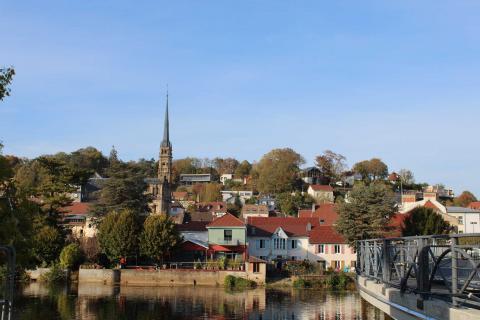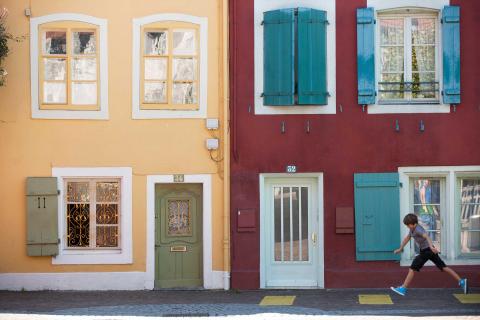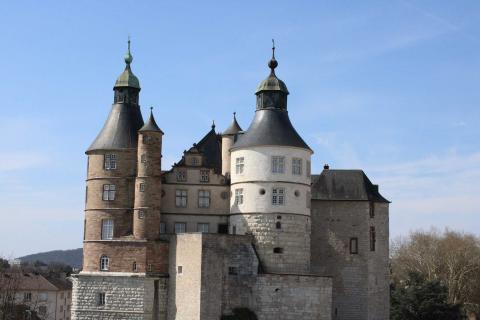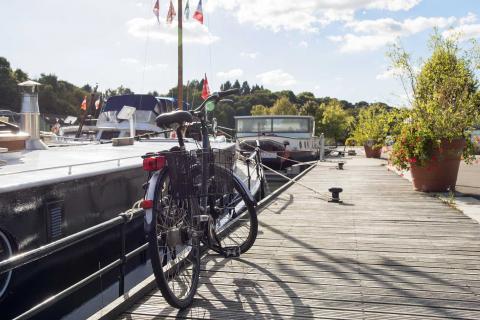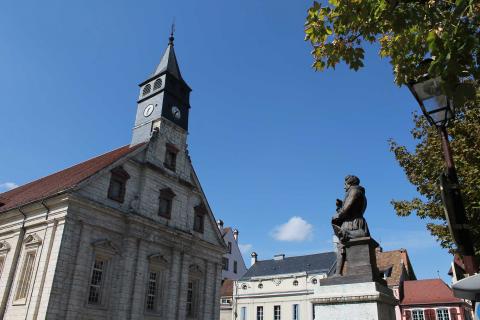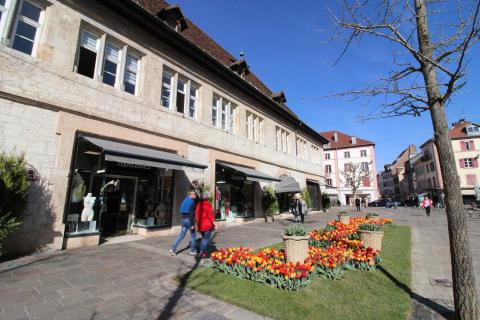
Montbéliard, the city of Princes
It all started on a rocky outcrop. From this fortified citadel overlooking the confluence of the Allan and Lizaine rivers, the first Counts of Montbéliard upheld a benevolent rule which attracted trade. A whole way of life developed around the base of the castle.
In 1397, the engagement of Henriette d'Orbe, heiress of the county to Eberhardt de Würtemberg, a young prince of the empire, brought the small state into the German Kingdom. This was followed by four centuries marked by the influence of Lutheran Protestantism and by the architectural creations of Heinrich Schickhardt, architect to Prince-Duke Frédéric I of Montbéliard-Wurtemberg. In 1556, Lutheranism became the state’s religion on the Prince’s orders. This remained the case until the area was incorporated back into France.
The first rumours about the Revolution came late to Montbéliard. The principality became French in 1793. The Lutheran culture, which was in the majority among employers, and the incorporation of the principality back into France led to immense industrial development. Families with an Anglo-Saxon outlook shaped the region and instilled a creative spirit. This was the era of the LesJapy family and the first century of the Peugeot venture.
Today, the ‘Villes et Pays d'Art et d'Histoire’accreditation for the Pays de Montbéliard confirms its position as an important cultural area. Its international events include magical festivals, street shows and the ‘Lumières de Noël’ (Christmas lights). The former Principality, imbued with an atmosphere which is unique in the Franche-Comté, has a regal air. Noblesse oblige!
A remarkable heritage
Montbéliard has inherited a rich and colourful heritage from the Dukes of Wurtemberg and the Princes of Montbéliard. Its similarities with towns in Baden-Württemberg are so numerous and so strong that you could be forgiven for thinking that you were on the other side of the Rhine.
The Château des ducs de Wurtemberg (13-19th century)
The main building and the Henriette (15th century) and Frédéric (16th century) towers contain a history trail, as well as a museum. The Georges Cuvier gallery and its historical natural history collections mean that visitors can find out about one of the greatest scholars of the 19th century.
Temple Saint-Martin (Saint-Martin Protestant church) (1601-1607):
The oldest French building dedicated to the Reformation. It is a symbol of the triumph of Lutheranism, as desired by the Duke of Württemberg, and was designed by the architect and town planner, Heinrich Schickhardt (1604).
Saint-Maimboeuf church (1850)
The church looks down over Saint-Martin Protestant church (1679), which is located below. It has a very intricate Neo-Renaissance façade and demonstrates the desire to confirm the return of Catholicism to this Protestant land.
There are several other places of architectural interest and beautiful buildings to explore, such as the Peugeot building, the Beurnier-Rossel hotel, the Les Logis house, colourful façades and ‘yorbes’ (turrets containing a staircase), etc.
> To find out all about the local heritage, take the ‘Heinrich Schickhardt et son temps’ (Heinrich Schickhardt and his era) urban trail. This 3 km managed trail in the heart of Montbéliard takes you to all the buildings designed by the famous architect to the Duke of Wurtemberg, who was also well-known amongst his contemporaries. The trail is suitable for people with reduced mobility as there are car parks located close to all the sites of interest.
A green haven
Montbéliard, which has had the ‘ville 4 fleurs’ accreditation since 1989, is a natural haven thanks to its gardens, parks and landscaped spaces which provide pleasant surroundings where many activities can be enjoyed.
Parc du Près-la-Rose (Près-la-Rose park):
Located between the Rhone-Rhine Canal and the river Allan, this park is both a leisure space and an ‘island’ of 10 hectares with around one hundred plant species, an arboretum and a giant maze. It is the perfect place to relax and enjoy a stroll. The park houses the Pavillon des Sciences which provides an alternative view of science through exhibitions and events.
The marina:
Montbéliard marina is open from April to September and welcomes pleasure boaters wishing to stop off or linger and explore the Pays de Montbéliard. Located on the Eurovéloroute 6 cycling route, this reception point, managed by the Tourist Office for the Pays de Montbéliard, is designed to welcome and inform boaters, cyclists and walkers, etc.
L’Île en Mouvement:
L’Île en Mouvement is a landscaped park with a natural appearance intended for walking and biodiversity and located on the edge of the marina and the Nantes-Budapest Eurovéloroute cycling route.
